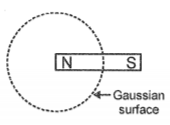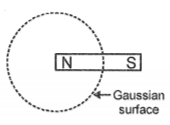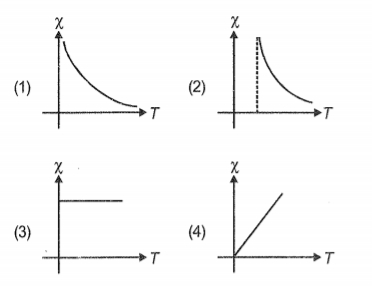Susceptibility of a substance at 300 K is -0.00002. Its susceptibility at 600K is
1. -0.00001
2. -0.00004
3. -0.00006
4. -0.00002
300 K पर किसी पदार्थ की चुंबकीय प्रवृत्ति -0.00002 है। 600K पर इसकी चुंबकीय प्रवृत्ति है:
1. -0.00001
2. -0.00004
3. -0.00006
4. -0.00002
Due to a small magnet, the intensity at a distance x in the end on position is 9 gauss. What will be the intensity at a distance on broadside on position?
1. 9 gauss
2. 4 gauss
3. 36 gauss
4. 4.5 gauss
एक छोटे चुंबक के कारण, अक्षीय स्थिति में x दूरी पर तीव्रता 9 गॉस है। निरक्षीय स्थिति पर की दूरी पर तीव्रता क्या होगी?
1. 9 गॉस
2. 4 गॉस
3. 36 गॉस
4. 4.5 गॉस
A Gaussian surface is drawn enclosing N-pole of a bar magnet. The net magnetic flux through the Gaussian surface will be (pole strength of N-pole is treated as positive and S-pole as negative)

1. Positive
2. Negative
3. Positive or negative
4. Zero
एक गाउसीय पृष्ठ को एक दंड चुंबक के N-ध्रुव को परिबद्ध करते हुए खींचा गया है। गाउसीय पृष्ठ के माध्यम से कुल चुंबकीय फ्लक्स होगा (N-ध्रुव की ध्रुव सामर्थ्य धनात्मक और S-ध्रुव की ध्रुव सामर्थ्य ऋणात्मक मानी जाती है)

*Gaussian surface - गाउसीय पृष्ठ
1. धनात्मक
2. ऋणात्मक
3. धनात्मक या ऋणात्मक
4. शून्य
What is the unit of pole strength of a bar magnet?
1. ampere-metre
2. ampere/metre
3. ampere/metre2
4. ampere-metre2
एक दंड चुंबक की ध्रुव सामर्थ्य का मात्रक क्या होता है?
1. ऐम्पियर-मीटर
2. ऐम्पियर/मीटर
3. ऐम्पियर/मीटर2
4. ऐम्पियर-मीटर2
Magnetic induction at an axial point of a short magnet at a distance r from the centre of dipole is . Its value at the equatorial point of the short magnet at the same distance from the centre of dipole is :
1. -
2.
3.
4.
द्विध्रुव के केंद्र से दूरी r पर एक लघु चुंबक के अक्षीय बिंदु पर चुंबकीय प्रेरण है। द्विध्रुवीय के केंद्र से समान दूरी पर लघु चुम्बक के निरक्ष बिंदु पर इसका मान है:
1. -
2.
3.
4.
The unit of intensity of the magnetising field is :
1.
2.
3.
4. All of these
चुम्बकीय क्षेत्र की तीव्रता का मात्रक होता है:
1.
2.
3.
4. ये सभी
The magnetic susceptibility  of a ferromagnetic material varies with temperature, as
of a ferromagnetic material varies with temperature, as

एक लौहचुंबकीय पदार्थ की चुंबकीय प्रवत्ति  ताप के साथ निम्नानुसार परिवर्तित होती है:
ताप के साथ निम्नानुसार परिवर्तित होती है:

A: Magnetic dip at the pole is .
R: Magnetic field at the pole is directed horizontally.
1. If both Assertion and Reason are true and the reason is the correct explanation of the assertion.
2. If both Assertion and Reason are true but the reason is not the correct explanation of the assertion.
3. If Assertion is a true statement but Reason is false.
4. If both Assertion and Reason are false statements.
A: ध्रुव पर चुंबकीय नति होता है
R: ध्रुव पर चुंबकीय क्षेत्र क्षैतिज रूप से निर्देशित होता है।
1. यदि अभिकथन और कारण दोनों सत्य होते हैं और इसका कारण अभिकथन की सही व्याख्या होती है।
2. यदि अभिकथन और कारण दोनों सत्य होते हैं लेकिन इसका कारण अभिकथन की सही व्याख्या नहीं होती है।
3. यदि कथन सही कथन होता है, लेकिन कारण गलत होता है।
4. यदि अभिकथन और कारण दोनों गलत कथन होते हैं।
At angle cos-1 to the magnetic meridian, the apparent dip is 60. The true dip at the place is :
1. 30
2. 45
3. 0
4. 60
चुंबकीय याम्योतर से कोण cos-1 पर आभासी नति कोण 60 है। उस स्थान पर वास्तविक नति कोण है:
1. 30
2. 45
3. 0
4. 60
The angle of dip is on a given meridian which is at an angle with the magnetic meridian. If is the angle of dip on another meridian which is perpendicular to the first meridian, then are related as :
1. cot2 = cot2+cot2
2. tan2 = tan2+tan2
3. tan =
4. tan = tan + tan
किसी दिए गए याम्योतर पर नति कोण है जो चुंबकीय याम्योतर के साथ कोण पर है। यदि किसी अन्य याम्योतर पर नति कोण है जो पहले याम्योतर के लंबवत है, तो , और निम्न से संबंधित हैं:
1. cot2 = cot2+cot2
2. tan2 = tan2+tan2
3. tan =
4. tan = tan + tan






